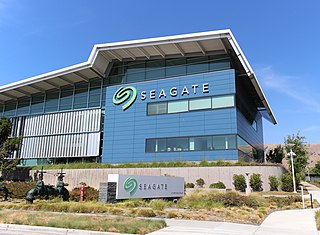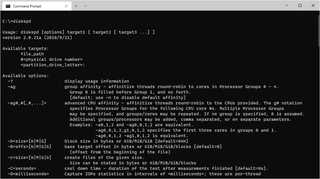
A hard disk drive (HDD), hard disk, hard drive, or fixed disk is an electro-mechanical data storage device that stores and retrieves digital data using magnetic storage and one or more rigid rapidly rotating platters coated with magnetic material. The platters are paired with magnetic heads, usually arranged on a moving actuator arm, which read and write data to the platter surfaces. Data is accessed in a random-access manner, meaning that individual blocks of data can be stored and retrieved in any order. HDDs are a type of non-volatile storage, retaining stored data even when powered off. Modern HDDs are typically in the form of a small rectangular box.

Disk partitioning or disk slicing is the creation of one or more regions on secondary storage, so that each region can be managed separately. These regions are called partitions. It is typically the first step of preparing a newly installed disk, before any file system is created. The disk stores the information about the partitions' locations and sizes in an area known as the partition table that the operating system reads before any other part of the disk. Each partition then appears to the operating system as a distinct "logical" disk that uses part of the actual disk. System administrators use a program called a partition editor to create, resize, delete, and manipulate the partitions. Partitioning allows the use of different filesystems to be installed for different kinds of files. Separating user data from system data can prevent the system partition from becoming full and rendering the system unusable. Partitioning can also make backing up easier. A disadvantage is that it can be difficult to properly size partitions, resulting in having one partition with too much free space and another nearly totally allocated.

Western Digital Corporation is an American computer hard disk drive manufacturer and data storage company, headquartered in San Jose, California. It designs, manufactures and sells data technology products, including storage devices, data center systems and cloud storage services.

Seagate Technology Holdings plc is a global data storage company. It was incorporated in 1978 as Shugart Technology and commenced business in 1979. Since 2010, the company has been incorporated in Dublin, Ireland, with operational headquarters in Fremont, California, United States.
IBM manufactured magnetic disk storage devices from 1956 to 2003, when it sold its hard disk drive business to Hitachi. Both the hard disk drive (HDD) and floppy disk drive (FDD) were invented by IBM and as such IBM's employees were responsible for many of the innovations in these products and their technologies. The basic mechanical arrangement of hard disk drives has not changed since the IBM 1301. Disk drive performance and characteristics are measured by the same standards now as they were in the 1950s. Few products in history have enjoyed such spectacular declines in cost and physical size along with equally dramatic improvements in capacity and performance.

Microdrive is a registered trademark for miniature, 1-inch hard disks produced by IBM and Hitachi. These rotational media storage devices were designed to fit in CompactFlash (CF) Type II slots. The release of similar drives by other makers led to them often being referred to as "microdrives" too. By 2010, Microdrives were viewed as obsolete, having been overtaken by solid-state flash media in read/write performance, storage capacity, durability, and price.
Micropolis Corporation was a disk drive company located in Chatsworth, California and founded in 1976. Micropolis initially manufactured high capacity hard-sectored 5.25-inch floppy drives and controllers, later manufacturing hard drives using SCSI and ESDI interfaces.

HGST, Inc. was a manufacturer of hard disk drives, solid-state drives, and external storage products and services.

Travelstar was a brand of 2.5-inch hard disk drives (HDD) that was manufactured by Western Digital. The brand was originally introduced by IBM in 1994 with the announcement of the Travelstar LP, a 2.5-inch 300MB 12.5 mm high HDD. IBM began shipping 2.5-inch HDDs in 1990 without this branding.
Storage Module Drive (SMD) is a family of storage devices that were first shipped by Control Data Corporation in December 1973 as the CDC 9760 40 MB (unformatted) storage module disk drive. The CDC 9762 80 MB variant was announced in June 1974 and the CDC 9764 150 MB and the CDC 9766 300 MB variants were announced in 1975. A non-removable media variant family of 12, 24 and 48 MB capacity, the MMD, was then announced in 1976. This family's interface, SMD, derived from the earlier Digital RP0x interface, was documented as ANSI Standard X3.91M - 1982, Storage Module Interfaces with Extensions for Enhanced Storage Module Interfaces.
In 1953, IBM recognized the immediate application for what it termed a "Random Access File" having high capacity and rapid random access at a relatively low cost. After considering technologies such as wire matrices, rod arrays, drums, drum arrays, etc., the engineers at IBM's San Jose California laboratory invented the hard disk drive. The disk drive created a new level in the computer data hierarchy, then termed Random Access Storage but today known as secondary storage, less expensive and slower than main memory but faster and more expensive than tape drives.

A solid-state drive (SSD) is a solid-state storage device that uses integrated circuit assemblies to store data persistently, typically using flash memory, and functioning as secondary storage in the hierarchy of computer storage. It is also sometimes called a semiconductor storage device, a solid-state device or a solid-state disk, even though SSDs lack the physical spinning disks and movable read–write heads used in hard disk drives (HDDs) and floppy disks.

In computer disk storage, a sector is a subdivision of a track on a magnetic disk or optical disc. Each sector stores a fixed amount of user-accessible data, traditionally 512 bytes for hard disk drives (HDDs) and 2048 bytes for CD-ROMs and DVD-ROMs. Newer HDDs use 4096-byte (4 KiB) sectors, which are known as the Advanced Format (AF).
The Durango F-85 was an early personal computer introduced in September 1978 by Durango Systems Corporation, a company started in 1977 by George E. Comstock, John M. Scandalios and Charles L. Waggoner, all formerly of Diablo Systems. The F-85 could run its own multitasking operating system called DX-85M, which included an integral Indexed Sequential (ISAM) file system and per-task file locking, or alternatively CP/M-80. DX-85M utilized a text configuration file named CONFIG.SYS five years before this filename was used for a similar purpose under MS-DOS/PC DOS 2.0 in 1983.

DiskSpd is a free and open-source command-line tool for storage benchmarking on Microsoft Windows that generates a variety of requests against computer files, partitions or storage devices and presents collected statistics as text in the command-line interface or as an XML file.

Terry Johnson was an engineer and entrepreneur notable for his pioneering work on hard disk drives (HDD). Johnson's early career included engineering and management roles in magnetic recording at IBM (1964–70) and Memorex (1971–73). He then joined in the development of STC 8000 Super Disk, a high-end, rotary actuator HDD funded by StorageTek.
Finis Conner is an American entrepreneur and pioneer of the disk drive industry, founding industry leaders Shugart Associates, Seagate Technology and Conner Peripherals. Conner Peripherals, a major HDD manufacturer, was founded in 1987, and by 1990 had become the fastest-growing start-up in the history of U.S. commerce up until that point. Conner Peripherals was acquired by Seagate in 1996.

The IBM ThinkPad 700 is the first notebook computer for the ThinkPad brand that was released by IBM on October 5, 1992. Another series was released alongside it, the ThinkPad 300 series. The 300 series was meant to be a cheaper, lower performance model line over the 700.












